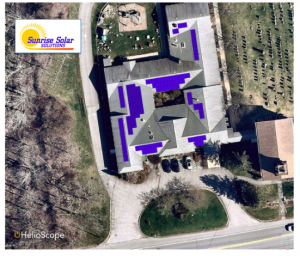Background
Our congregation is considering taking advantage of the “Solarize Our Congregation” initiative sponsored by HRP Green (the Presbytery’s Green Team). In this article we (the Green Team) provide key details about the proposal, offer some information about solar energy economics and physics, and explain why we think it would be a great idea for FPCY to join other congregations in our presbytery who are going solar.
Proposal
Sunrise Solar Solutions is the vendor selected by HRP Green, A team from HRP Green reviewed proposals from a number of solar providers, and chose Sunrise Solar in Briarcliff Manor as the provider for congregations in our part of the Presbytery. You can learn more about Sunrise Solar here.
 Their proposal is to install 144 solar panels (each about 20 square feet in area) on the roof of the Christian Education building. No panels would be installed on the Sanctuary itself. (see picture to the left for proposed panel placement. The actual panels will be black.) There is a companion proposal to also solarize the church manse. This has a number of advantages but is beyond the scope of this article.
Their proposal is to install 144 solar panels (each about 20 square feet in area) on the roof of the Christian Education building. No panels would be installed on the Sanctuary itself. (see picture to the left for proposed panel placement. The actual panels will be black.) There is a companion proposal to also solarize the church manse. This has a number of advantages but is beyond the scope of this article.
This proposal to solarize the CE building is projected to generate over 42kW of peak power on average, and over 47,000 kilowatt-hours annually. Based on our current usage, the solar energy generated by the panels is estimated to provide 96% of our church facility’s electrical power needs. Our power would remain just as reliable as it is today because we would still be tied into the existing power grid; however almost all of the electrical power we use would come from renewable energy, as opposed to fossil fuels.
How Does Solar Power work?
Simply put, a solar panel works by allowing photons, or particles of light, to knock electrons free from atoms, generating a flow of electricity. The basic units are small photovoltaic cells that convert sunlight into electricity. Solar panels consist of many such cells linked together.
Solar panels require practically no maintenance. They have no moving parts. Snow doesn’t have to be removed; it usually slides quickly and easily off of the sloped, smooth panels. The life span of the panels (during which they will produce at least 80% of their initial output) is about 25 years, which is similar to the lifespan of a typical roof. The micro inverters also have a lifespan of about 25 years; these ensure that even if one panel is shaded or covered with snow, those that remain unobstructed can still produce their peak power.
What happens when the sun isn’t shining? How could solar panels possibly continue to supply power at night, or on cloudy days, or in the winter when snow covers the roof? Well, they can’t — but that’s OK! Our power will still flow reliably, without a hitch. Here’s how that will work.
Our solar energy installation will tie into the power grid. During sunny days, we will generate more power than we need. We will feed this extra power back into the grid, thereby earning credits from the power company. At night, or on cloudy or snowy days, the power company will supply us just as it does today — except that instead of paying them money, we’ll just pay them with the credits that we earned from the excess power that we generated during sunny periods. Averaged over the year, our solar panels will therefore be responsible for 96% of our total usage. In effect, we will be using the power company as a big battery.
Someday, we may be able to use actual batteries to store excess power. That will certainly be useful during power outages! However, such batteries are more expensive than they are worth today, so we will have to wait a few years for the technology to become cheaper before we explore that option.
If you want more details about exactly how a solar energy system works, this article is a good resource: https://us.sunpower.com/blog/2017/10/25/how-does-solar-energy-work/.
Why Go Solar?
Your Green Team is excited about the prospect of joining other congregations in the Hudson River Presbytery who are going solar. We see several significant benefits to doing so:
- Thanks to various subsidies and incentives (which expire in the next few years) going solar is surprisingly affordable and will almost certainly produce financial savings for the church over the lifetime of the panels. More details will be provided about the financial costs and benefits once the church leadership has had an opportunity to review them. In the meantime, it is safe to say that should FPCY go solar, we will spend the same amount or less than we do currently on our electrical energy needs, and all of that money will go toward renewable energy instead of fossil fuels (which ultimately cost us more in the long run in terms of environmental damage and instability).
- Solarizing is a good way to live one of our core values as a Green Faith congregation – being good stewards of the Earth. One way to think about this is: For every year we rely primarily on solar energy, we will be keeping as much carbon out of the atmosphere as 42 acres of forest. Alternatively, we will be saving the equivalent of 87,000 miles worth of CO2 emissions from a car.
- We will be a leading light for our community. People driving past our church on routes 202 or 132 may notice the panels on the roof of our Christian Education building (again, nothing would be installed on the sanctuary). When they see those panels, they will learn something about our values as people of faith seeking to be good stewards of God’s gifts and God’s earth. They might even be inspired to go to solar themselves. Perhaps they will also be inspired to explore the church community which congregates beneath those solar panels and puts its faith into action in such a visible way.
~Connie Knapp and Donna Gresh, Green Team co-chairs
